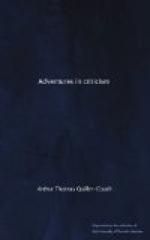His later Manner.
For here the luck ended. All over Europe there began to spread influences that may have been good for some artists, but were (we may say) peculiarly injurious to so naif and, at the same time, so personal a writer as Bjoernson. I think another age will find much the same cause to mourn over Daudet when it compares his later novels with the promise of Lettres de Mon Moulin and Le Petit Chose. Naturalism demands nothing more severely than an impersonal treatment of its themes. Of three very personal and romantic writers, our own Stevenson escaped the pit into which both Bjoernson and Daudet stumbled. You may say the temptation came later to him. But the temptation to follow an European fashion does, as a rule, befall a Briton last of all men, for reasons of which we need not feel proud: and the date of Mr. Hardy’s stumbling is fairly recent, after all. Bjoernson, at any rate, began very soon to be troubled. Between 1864 and 1874, from his thirty-second to his forty-second year, his invention seemed, to some extent, paralyzed. The Fisher Maiden, the one story written during that time, starts as beautifully as Arne; but it grows complicated and introspective: the psychological experiences of the stage-struck heroine are not in the same key as the opening chapters. Passing over nine years, we find Magnhild much more vague and involved—
“Here he is visibly affected by French models, and by the methods of the naturalists, but he is trying to combine them with his own simpler traditions of rustic realism.... The author felt himself greatly moved by fermenting ideas and ambitions which he had not completely mastered.... There is a kind of uncomfortable discrepancy between the scene and the style, a breath of Paris and the boulevards blowing through the pine-trees of a puritanical Norwegian village.... But the book is a most interesting link between the early peasant-stories and the great novels of his latest period.”
Well, of these same “great novels”—of Flags are Flying and In God’s Way—people must speak as they think. They seem to me the laborious productions of a man forcing himself still further and further from his right and natural bent. In them, says Mr. Gosse, “Bjoernson returns, in measure, to the poetical elements of his youth. He is now capable again, as for instance in the episode of Ragni’s symbolical walk in the woodlands, In God’s Way, of passages of pure idealism.” Yes, he returns—“in measure.” He is “capable of idyllic passages.” In other words, his nature reasserts itself, and he remains an imperfect convert. “He has striven hard to be a realist, and at times he has seemed to acquiesce altogether in the naturalistic formula, but in truth he has never had anything essential in common with M. Zola.” In other words, he has fallen between two stools. He has tried to expel nature with a pitchfork and still she runs back upon him. He has put his hand to the plough and has looked back: or (if you take my view of “the naturalistic formula”) he has sinned, but has not sinned with his whole heart. For to produce a homogeneous story, either the acquired Zola or the native Bjoernson must have been cast out utterly.




